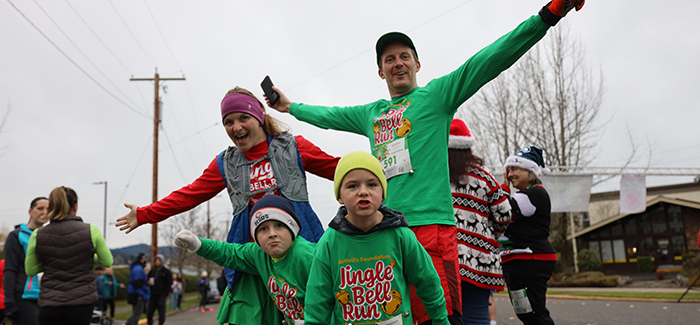10 Tips for Cold Weather Exercise
Stay active on cold winter days to ease your arthritis.
By Linda Melone | Updated Dec. 8, 2021
It’s tempting to huddle up on the sofa on cold winter days, but arthritis knows no season. A lack of activity can cause your joints to become stiff, so move it or lose it. Studies show that people with arthritis and related diseases – including osteoarthritis, rheumatoid arthritis, psoriatic arthritis and fibromyalgia – benefit from regular exercise. Physical activity eases arthritis pain, increases strength and flexibility, boosts your energy and improves your overall quality of life. Find an activity that works for you and try these tips to keep going when the temps drop.
Time it right. Joint stiffness may be worse when you first wake up, making an early morning workout uncomfortable and painful. If so, take your walk later in the day when it’s warmer outside and your joints have loosened up. Plus, if you’re taking pain medications, waiting gives them a chance to kick in before you exercise. To warm your joints up faster, pop your workout clothes in the dryer for five minutes while you get ready.
Dress in loose layers. Wear comfortable layers that you can take off as you warm up and put on (or zip up) as you finish, says Nader Nassif, MD, orthopedic surgeon at Hoag Orthopedic Institute in Irvine, California. Loose layers trap body heat and keep joints warm. Be careful not to overdress, however. “After your warm-up, you can potentially become overheated if you are wearing too many layers,” says Dr. Nassif. In general, start with a thin, synthetic layer (not cotton), add a layer of fleece, and top with a waterproof, breathable outer layer.
Drink up. Hydration is more often associated with sweating and the summer months, but it’s just as important to drink plenty of water in winter, too. You still sweat and lose fluid in cold weather, says Dr. Nassif. “Make sure you stay hydrated before, during and after your workout.” Dehydration can affect mood and even brain function. In general, drink about 16 ounces (two cups) of water two hours before a workout.
Protect your extremities. Working out in cold weather exposes your hands, feet, ears and nose to severe temperatures. If you have Raynaud’s disease, a condition that causes abnormal sensitivity to cold and restricts blood flow to fingers and toes, wear mittens instead of gloves and use chemical hand warmers in your mittens and boots. Keep your head and ears warmer with a hat or beanie.
Wear sunblock. Even in the cold, a sunny day can result in sunburn, says Dr. Nassif. This is especially true if you have psoriasis or lupus, or if you take nonsteroidal anti-inflammatory drugs (NSAIDs) or methotrexate, which can make your skin more sun-sensitive. “Make sure you wear appropriate sunscreen (SPF 50) on exposed parts and protect your eyes with sunglasses or ski goggles.” Remember to reapply if you’re sweating or after more than two hours outdoors. Include a soothing lip balm with sunscreen to prevent windburn and sunburn.
Calling All Jinglers!
It’s Time to Join the Fun at Jingle Bell Run
Be a part of the most festive fun run there is while helping to improve the lives of millions of people living with arthritis. Your participation will help raise awareness and funds for life-changing research and resources.
Register Today
Get traction. Ice isn’t the only danger when walking or exercising outdoors. Packed snow can also make you lose your footing and cause a fall. “Look for ways to get added traction,” says Tom Holland, exercise physiologist and fitness consultant. He recommends simple cleats to strap on your shoes that provide traction when walking on ice or snow. Trail shoes also provide more grip and stability than running or walking shoes that are made for the road.
Safety first. Take a phone and let people know where you’re going, says Holland. “If you slip or fall while walking or biking it’s a good idea someone knows where they can find you.” In addition, choose a neighborhood that’s familiar to you, so if large snowbanks or road detours prevent you from taking your regular route, you’ll know how to find your way back home, Holland adds.
Warm up and cool down. Before you go outside, spend a few minutes warming up, which is especially important when you have arthritis. “The goal is to warm up your core. This helps loosen up your joints and gives your muscles added flexibility,” says Holland. Warm up by marching in place or on a treadmill for 5 to 10 minutes at a slow-comfortable pace, and then stretching out all major muscle groups. After your workout, take time to cool down and stretch out.
Think low-impact. Cardiovascular exercise does not have to include high-impact exercise such as skiing, jogging or running. Snowshoeing, cross-country skiing and walking are low-impact cardio options that are not only easier on joints but also provide all the benefits of physical activity.
Take it inside. On the coldest winter days it’s best to work out indoors where you can more easily control the environment. Walk at the mall, pedal a stationary bike, go for a swim at the local aquatic center or take an exercise class at the gym. According to the American College of Sports Medicine, cold weather itself should not be a barrier to exercising outdoors, especially if you are accustomed to it. However, those with Raynaud’s syndrome, heart disease or asthma are at highest risk of being impacted by the cold and may need to avoid outdoor exercise in frigid temperatures altogether.

Stay in the Know. Live in the Yes.
Get involved with the arthritis community. Tell us a little about yourself and, based on your interests, you’ll receive emails packed with the latest information and resources to live your best life and connect with others.


